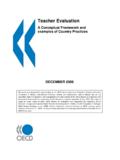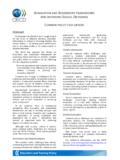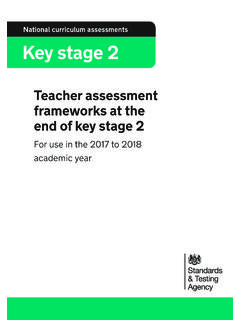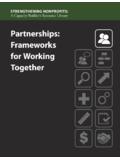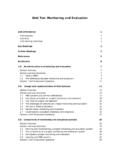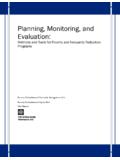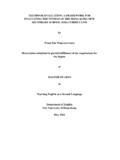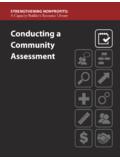Transcription of Assessment and Evaluation of Objectives and …
1 Assessment and Evaluation of Objectives and Outcomes forContinuous improvement of an industrial EngineeringProgram*K. JO MIN, JOHN JACKMAN and DOUG GEMMILLD epartment of industrial and Manufacturing Systems engineering , 3004 Black, Iowa State University, Ames, IA 50011, : recent years, ABET accreditation has placed a heavy emphasis not only on the Assessment of Objectives and outcomes,but also on the Evaluation of them and subsequent efforts for continuous improvement based on such an , a plethora of Assessment tools and conceptual frameworks notwithstanding, there exists a relative paucity ofdocumented efforts on the actual Evaluation and subsequent continuous improvement .
2 In this paper, we first concretely (1)show how such Assessment and Evaluation can be deliberately and systematically conducted in the context of an IndustrialEngineering program. We then (2) show how the results of the Objectives Evaluation lead to the efforts towards continuousimprovement through the student outcomes. Through (1) and (2), we enable others to specifically identify and prepare forthe critical stages necessary to advance beyond a display of Assessment tools and conceptual frameworks and to actuallyclose the loop for a continuous improvement : Assessment ; Evaluation ; Objectives ; outcomes; continuous improvement1. IntroductionIn engineering programs throughout the USA aswell as increasingly in non-US programs, ABET accreditation has often become a mandatory mini-mum standard that must be maintained [1].
3 At thesame time, ABET accreditation has focused notonly on the Assessment of Objectives and outcomesof engineering programs, but also on the evaluationof them and the subsequent efforts towards contin-uous improvement based on such evaluations [2].In practice, however, there exists a plethora ofassessment tools and conceptual frameworks ( , [3], [4]) and a relative paucity of documentedefforts on the actual Evaluation and subsequentcontinuous improvement (see , [5]).In particular, under these circumstances, it ishighly desirable to document step by step how theABET expectations can be met so that variousaccreditation stakeholders may be able to specifi-cally identify and prepare for the critical stagesnecessary to advance beyond Assessment tools andconceptual frameworks and to close the loop for acontinuous improvement specifically asks stakeholders to [6]:1.
4 Document your processes for regularly asses-sing and evaluating the extent to which theprogram s educational Objectives and studentoutcomes are being attained;2. document the extent to which the program seducational Objectives and student outcomesare being attained; and3. describe how the results of these processes arebeing used to effect continuous improvement inthe this paper, in view of these expectations, we aimto contribute by actually demonstrating how eachof these expectations can be met step by step in thecontext of an industrial engineering program ( , [7] in the context of environmental sustain-ability education and [8] in the context of interna-tional supply chain education).
5 In so doing, we hope to bridge the gap betweenthe plethora of abstract frameworks and the paucityof documented practices a little bit at a time. Bydocumenting this practice, we also hope to stimulatediscussion in this important area of the outcome andobjective assessments and evaluations, as well as thesubsequent continuous efforts for , we hope all such activities will positivelycontribute toward better learning experiences bystudents in engineering , our responses to these expec-tations heavily depend on a series of gap analyses(see , [9]) and exploit triangulations for robust-ness of our findings (see , [10]). In so doing, forexample, it will be clear that the identification of theareas for improvement will be systematic and delib-erate.
6 It will also be clear that the pieces of evidencesupporting our findings will come from differentassessment methods and from different , it is also hoped that others will be able tounderstand and rely on such gap analyses and* Accepted 14 September Journal of engineering EducationVol. 29, No. 2, pp. 520 532, 20130949-149X/91 $ + in Great Britain#2013 TEMPUS for results that are not haphazardlyobtained/attained, and further facilitate discussionand exchange of ideas on the methodology rest of the paper is organized as follows. InSection 2, we present the IE ( industrial engineering )program background, program s educationalobjectives (PEOs), and student outcomes, andshow how they are related.
7 Next, in Section 3, wepresent how the Assessment and Evaluation of theobjectives can be systematically conducted. In Sec-tion 4, for student outcomes, we show how theassessment and Evaluation are conducted. This isfollowed by Section 5, presenting how the results ofthe PEO s Evaluation lead to the improvementefforts through the student outcomes. In Section 6,we further comment on our experiences thus far anddiscuss future endeavors. Finally, in Section 7, wegive our Program s educational Objectives andstudent outcomesIowa State University (ISU) is a land-grant institu-tion with obligations to teach practical classes thatwill provide students with the knowledge to make adifference in the world.
8 This ISU mission presents aclear vision for an educational philosophy thatmatches closely the goals of the undergraduatecollege of engineering : to provide students withthe kind of training that will allow them to make adifference in our state, nation and around the achieve this mission, the industrial engineering (IE) program for the Bachelor of Science (BS)degree must be responsive to the needs of relevantindustries, such as manufacturing and , the feedback from the relevant industries,alumni, and current students who often have co-opand internship experiences provide informationthat should be used to improve our programsthrough efforts towards continuous one can subsequently observe, this ISU mis-sion-based philosophy greatly influences the assess-ment and Evaluation processes of the IE educationalprogram Objectives (PEOs) and student outcomes,as well as the IE program continuous improvementprocess.
9 In what follows, we describe the PEOs,student outcomes, and their Program s educational objectivesThe IE Program educates its future graduates toaccomplish its educational Objectives in their earlycareers. Specifically, the IE curriculum prepares itsmajors so that, within a few years of graduation, thegraduate has1. made industrial engineering decisions thatresult in well-reasoned, value-added solutions;2. had communications with stakeholders that areinformative, persuasive and constructive;3. made contributions to team goals througheffective team interactions and leadership; and4. attained new skills and knowledge that advancetheir professional practice and enable Objectives deliberately and systematicallysupport the ISU mission as they not only emphasizethe technical achievements, but also professionalpractice-related achievements in communications,teamwork, and continual learning by our primary constituencies of the program andhow they relate to it are: 1.
10 Faculty, 2. Students, and 4. Industries. We do note that there areother stakeholders (but not the primary constitu-encies), such as university administrators, as well asprofessional societies and other relevant organiza-tions such as the Institute of industrial Engineers(IIE) and Student outcomesThe IE Program has the following student out-comes.(a) An ability to apply knowledge of mathematics,science and engineering (b) An ability to design and conduct experiments,as well as to analyze and interpret data(c) An ability to design a system, component, orprocess to meet desired needs within realisticconstraints, such as economic, environmental,social, political, ethical, health and safety, man-ufacturability and sustainability(d) An ability to function on multidisciplinaryteams(e) An ability to identify, formulate and solveengineering problems(f) An understanding of professional and ethicalresponsibility(g) An ability to communicate effectively(h)



